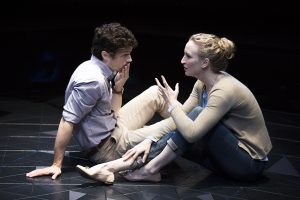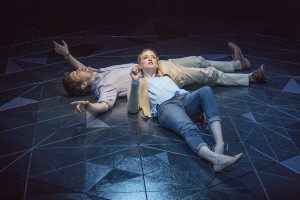Quantum Mechanics and Human Relationships Resonate in ‘Constellations’
Once upon a time, at the dawn of the computer age, some people thought that they could understand human thinking, and ultimately human behavior by studying how computers needed to “think” to solve problems. Turned out that the idea was way too simplistic, even though the notion of modeling human and mechanical thought processes after each other was somewhat productive (at least on the mechanical side).
The Old Globe’s production of Nick Payne’s play Constellations revives the idea, this time using theoretical physics as the modeling tool. The result is a somewhat enlightening, somewhat maddening, 65 minutes of well-crafted theatre.
Roland (Christian Coulson) and Marianne (Victoria Frings) are Londoners who meet and begin a romantic relationship (or don’t). Their relationship survives (or doesn’t) problems with sexual fidelity. In any case, they are apart for a while. They run into each other again and perhaps begin the relationship anew (or, maybe not). Roland proposes, and Marianne does (or doesn’t) accept. A health concern strikes one of the characters (always the same one). The condition needs surgery, but the outlook is optimistic (or pessimistic). The couple are sometimes loving and caring toward one another, and sometimes they fight.
Sound like a plot you’d enjoy seeing? Perhaps.
Here’s another wrinkle: Marianne works at Cambridge – in physics. Roland is a bee-keeper. Bees, as Roland explains at one point (several times) are very predictable. The female bees (workers) gather pollen, make honey and other byproducts, and tend the young. The male bees (drones) provide sperm for the eggs, which are laid only by the Queen. While bees may be said to be “social” their roles are defined strictly.
Marianne would probably call bee society an example of the theory of relativity. All functions fit together neatly and are predictable in relation to one another.
But, Marianne knows about physics theories that challenge relativity. The primary challenger is the theory of quantum mechanics, which sees physical forces as having relationships that have varying degrees of probability of occurring. An off-shoot of this approach is called “string theory,” because it sees elements such as protons or electrons as “strings” instead of “blobs,” and because the strings’ relationships are defined by how well they “resonate” together.
[quote]there can be multiple versions of reality, each co-existing with one another and each associated with a probability of occurring…[/quote]
If you want to read an interesting account of how these physics ideas differ from each other and what are the consequences of those differences, click here.
Marianne is definitely a “string” person, and she looks to resonate in her relationships. Roland, on the other hand, is more of a relativity person, but not so much that he is insensitive.
What Marianne sees, though, as a string person, is that there can be multiple versions of reality, each co-existing with one another and each associated with a probability of occurring.
 Mr. Payne’s play sets out to show the audience a number of the different realities for Marianne and Roland’s relationship. Each version starts out the same but varies depending on the direction one of the characters takes. Roland and Marianne remain roughly the same people throughout but their relationship resonates differently based on the choices they perceive they have as they converse with each other.
Mr. Payne’s play sets out to show the audience a number of the different realities for Marianne and Roland’s relationship. Each version starts out the same but varies depending on the direction one of the characters takes. Roland and Marianne remain roughly the same people throughout but their relationship resonates differently based on the choices they perceive they have as they converse with each other.
So, scenes are played multiple times, from multiple perspectives, starting from multiple places on the stage. Some people will be fascinated by how the choices change the way these characters vibrate; others will be bored or annoyed by the repetitive nature of the scenes. I was in the fascinated camp; my guest was in the bored/annoyed camp. You have been warned.
Richard Seer is an “actor’s director” and an ideal choice to direct Constellations. He’s worked his cast on the internal dynamics of each variation of the story with an eye to providing the audience with clues to the resonance between the characters. It’s masterful work and worth the price of admission by itself if you like watching the direction (and, I do).
On Broadway, these two roles were played by Jake Gyllenhaal and Ruth Wilson, both of whom were best known to audiences for their film and television work. Mr. Coulson and Ms. Frings are not as likely to sell tickets for an unfamiliar play, but their work, individually and together, is admirable. They even play a highly expressive scene using only sign language (Tracy Norris served as sign language consultant, and this extended scene looked like real signing to me).
The technical elements are, by design of the playwright, other-worldly (except for the deliberately nondescript costumes). They are executed expertly by the creative team (Scenic Design by David Israel Reynoso, Costume Design by Elisa Benzoni, Lighting Design by Bradley King, Sound Design by Fitz Patton).
As it happened, I had a meeting in the San Diego State physics building the same day that Constellations opened. That meeting illustrated the principle of relativity. The meeting room stayed the same, but my perspective on where it was located changed as I learned that there was not only a physics building but a physics/astronomy building (the two are connected, but apparently the floors aren’t entirely aligned). After seeing Constellations, I wished that I had absorbed some of the physics theory by osmosis while in the building, even though I enjoyed the production and how it was performed. Having better insight into how the play fit the theories it was illustrating would have enhanced my enjoyment greatly.
Of course, your mileage may vary. Almost certainly.
[box]Performs Tuesdays through Sundays, with matinees on Saturdays and Sundays, at the Sheryl and Harvey White Theatre on the Old Globe campus. Confirm start times when purchasing tickets. There is limited free parking nearby but substantial free parking throughout Balboa Park, if you don’t mind walking. Valet service and reserved parking in the San Diego Zoo’s employee lot are available if you do, or if walking distances is difficult. Tickets are available at the box office or online. See below for details. This review is based on the press opening, April 14.
DOWNLOAD PROGRAM HERE[/box]



